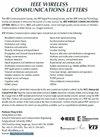雨和云散射下FSO车-星链路的C/N和误码率评估
IF 5.5
3区 计算机科学
Q1 COMPUTER SCIENCE, INFORMATION SYSTEMS
引用次数: 0
摘要
本文对采用自由空间光学(FSO)通信的空-空-地综合网络(SAGIN)中的载波噪声比(C/N)和误码率(BER)进行了深入的研究。重点是理解衰减对光链路的影响,以提供如何减轻其影响和支持链路增强的见解。降雨衰减和云散射是影响FSO链路性能的两个重要因素。这些链路对于在大气条件不断构成挑战的SAGIN进行高速、可靠的通信至关重要。为了应对这些挑战,我们应用Lin模型和国际电联模型来精确表征降雨衰减,并结合理论模型来模拟云散射。这种双重方法能够详细评估导致C/N退化的因素及其在不同大气条件下对BER的后续影响。通过分析这些影响,我们的目标是提高通信的效率和可靠性。我们的方法包括深入探索真实场景中的信号传播和衰减行为,从而制定提高网络弹性和性能的策略。本文章由计算机程序翻译,如有差异,请以英文原文为准。
Evaluating C/N and BER in FSO Vehicular-HAP-Satellite Links Under Rain and Cloud Scattering
This letter conducts a thorough investigation into Carrier-to-Noise Ratio (C/N) and the analysis of Bit Error Rate (BER) within a Space-Air-Ground Integrated Network (SAGIN) that employs Free Space Optical (FSO) communications. The focus is particularly set on understanding the impact of attenuation on optical links to offer insights on how to mitigate its effects and support link enhancement. Rain attenuation and cloud scattering are two significant factors that influence the performance of FSO links. These links are essential for high-speed, reliable communication in SAGIN, where atmospheric conditions pose a constant challenge. To address these challenges, we have applied the Lin model and ITU model for a precise characterization of rain attenuation and incorporated theoretical models to simulate cloud scattering. This dual approach enables a detailed assessment of the factors leading to C/N degradation and their subsequent impact on BER across varying atmospheric conditions. By analyzing these effects, we aim to enhance the efficiency and reliability of communications. Our methodology involves an in-depth exploration of signal propagation and attenuation behaviors in real scenarios, leading to developing strategies to improve network resilience and performance.
求助全文
通过发布文献求助,成功后即可免费获取论文全文。
去求助
来源期刊

IEEE Wireless Communications Letters
Engineering-Electrical and Electronic Engineering
CiteScore
12.30
自引率
6.30%
发文量
481
期刊介绍:
IEEE Wireless Communications Letters publishes short papers in a rapid publication cycle on advances in the state-of-the-art of wireless communications. Both theoretical contributions (including new techniques, concepts, and analyses) and practical contributions (including system experiments and prototypes, and new applications) are encouraged. This journal focuses on the physical layer and the link layer of wireless communication systems.
 求助内容:
求助内容: 应助结果提醒方式:
应助结果提醒方式:


